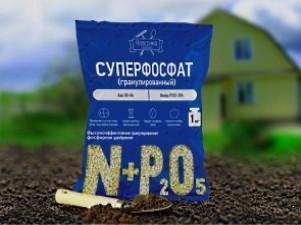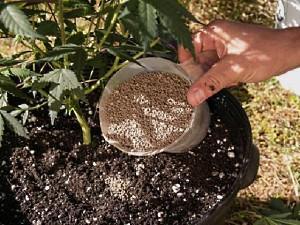Effective use of superphosphate fertilizer
 Sometimes even well-groomed summer cottage plants can lose their shape: they wither, and the leaves become blue-violet in color. In this case, the use of superphosphate fertilizer is necessary.
Sometimes even well-groomed summer cottage plants can lose their shape: they wither, and the leaves become blue-violet in color. In this case, the use of superphosphate fertilizer is necessary.
Phosphorus is a necessary substance to ensure normal life and development of a plant. The natural saturation of the soil with this useful substance is only 1%, and the compounds available with it are even less.
Phosphorus participates in energy metabolic processes, providing nutrition for plant cells, as well as in photosynthesis. Thanks to this, the yield increases, and the plants acquire the strength for accelerated growth.
Fertilizer superphosphate is made on the basis of phosphorus-nitrogen compounds, in combination with trace elements and minerals. Such a composition is saturated with many natural substances necessary for good growth and development of fruits.
The universal fertilizer superphosphate helps to increase the yield. The complex of trace elements accelerates the flowering process and the overall development of the root system and shoot, and also provides cure and protection against the occurrence of various diseases.
Fertilizers
The complex phosphorus-nitrogen compound has two main types:
- Simple superphosphate. The concentration of phosphorus in the fertilizer is concentrated at 25%, nitrogen - up to 8%, sulfur - up to 10% and calcium sulfate (gypsum) at 40%. Simple superphosphate is commercially available in two forms: powder and granules.
- Double superphosphate. It, accordingly, contains twice as much easily digestible phosphorus (45-55%). The capacity of nitrogen is 17% and sulfur is 6%. Double superphosphate is produced, mainly in granules, which dissolve easily in plain water.

How to use superphosphate simple
 To achieve a high result, it is necessary to know the principles of interaction and the necessary proportions for specific plants or horticultural crops. How superphosphate fertilizer is used is indicated on the package or in the attached instructions.
To achieve a high result, it is necessary to know the principles of interaction and the necessary proportions for specific plants or horticultural crops. How superphosphate fertilizer is used is indicated on the package or in the attached instructions.
A simple and double composition of a universal, complex phosphorus-nitrogen fertilizer can be used when planting seedlings or seeds in any soil. There are also no restrictions for horticultural crops and tree seedlings.
However, when applying this fertilizer, you need to take into account a small nuance - superphosphate acts poorly in acidic soils.
So that the fertilizer does not lose its nutritional properties, it is necessary to deoxidize the woody soil ash or a lime mixture (500 ml of lime or 0.2 kg of ash must be counted on 1m2 soil).
 The complete deoxidation process takes a long time. After one month, superphosphate can be applied to the soil. Only after this period, not earlier. The most effective way to introduce simple superphosphate is to directly pour it into rows or holes dug for planting plants or seedlings. Summer residents recommend planting seedlings immediately after fertilizing.
The complete deoxidation process takes a long time. After one month, superphosphate can be applied to the soil. Only after this period, not earlier. The most effective way to introduce simple superphosphate is to directly pour it into rows or holes dug for planting plants or seedlings. Summer residents recommend planting seedlings immediately after fertilizing.
Simple superphosphate is widely used for fertilizing loose soils, sandy loam, podzolic soils. Plants that consume a lot of sulfur (turnips, potatoes, beets, flax, carrots, radishes, bulbs of any plants) have an excellent growth rate and rapid development.
Remember that when working with superphosphate, it is strictly forbidden to create mixtures of ammonium nitrate, chalk, lime, urea.
Superphosphate is an independent universal fertilizer obtained from natural minerals (mineralization of animal skeletons and iron ore processing slag). Its effective use is possible only in accordance with the recommendations of specialists.
Superphosphate instructions for use
 Fertilizer superphosphate double is applied to the soil in early spring before planting, or in the fall, after harvesting. Phosphorus must have time to settle into the soil. In the interval between the main inputs of fertilizer, it is also recommended to provide for watering the plants about two times.
Fertilizer superphosphate double is applied to the soil in early spring before planting, or in the fall, after harvesting. Phosphorus must have time to settle into the soil. In the interval between the main inputs of fertilizer, it is also recommended to provide for watering the plants about two times.
Fertilizer superphosphate, instructions for use:
- The even spreading of double superphosphate is best done with a seed drill, as it is in the form of granules;
- The main application of double superphosphate should be carried out before sowing garden crops. This is usually done under the plow. From the initial application, the granular fertilizer is not washed off by irrigation or rainwater and does not fall below the sowing layer;
- The use of methods of manual spreading of granules is less effective, since this fertilizer must be located closer to the root system of crops;
- Many summer residents use double superphosphate formulations in combination with nitrogen-potassium and potassium fertilizers, which are applied in spring and, accordingly, in autumn.
For seedlings of vegetables and herbs, they are introduced into the soil from 30 to 40 g per square meter of double superphosphate. To feed a garden fruit tree in the fall, it is necessary to add up to 600 g of double superphosphate per 1 m2 to the soil. For seedlings and plants in greenhouses and hotbeds, use 100 g / 1m2... It is necessary to add 4 g of double superphosphate to the ditch with potatoes. In the case of depleted soil, the amount of fertilizer must be increased by 30%.
Young seedlings and seedlings of trees and bushes are especially in need of replenishment and fertilization, since there is no other way to obtain vital substances. Today's market offers a diverse range of nutrients, the first of which is superphosphate.
I completely agree with the author of the article that for a good harvest, the plants need to be fed. Superphosphate is a good and effective fertilizer. Most often I use double superphosphate granules. I feed them the first time the seedlings in a greenhouse, and then, the second time, already in the open field, when the seedlings take root. I use superphosphate mainly for tomatoes, peppers, cabbage. The proportions are the same as described in the article. I am very pleased with the result.
Superphosphate is a fertilizer that, in addition to phosphorus, supplies the plant with trace elements and nitrogen. Phosphorus itself is an element of life. It is he who participates in the development of roots, the creation of immunity. A sign of a lack of phosphorus in seedlings and young plants is the purple color of the leaf blade, a dull look and lack of growth. But you should not rush to feed in the spring. The reason may be in the cold ground. At low temperatures, plants do not absorb phosphorus. Therefore, before adding fertilizer, you need to analyze why it is not enough. And in the preparation of wintering plants in the second half of summer, phosphorus and potassium are needed. One of the unpleasant properties of superphosphate is that its unused residue is gypsum. Therefore, in the greenhouse, I try to do top dressing with a superphosphate extract, pouring the sediment into a compost heap.
Kind time of the day. I can't figure out how much water you need to dilute double superphosphate? thanks for the answer
During the growing season, for irrigation, 20-30 g of double superphosphate are diluted for 10 liters of water.
I understood how to dilute, thanks, but it dissolves poorly in water, I was told that you can boil and the sediment dissolve. Is this true? Will the nutrients go away if you boil?
Superphosphate is diluted in warm water, but not more than 50 degrees.